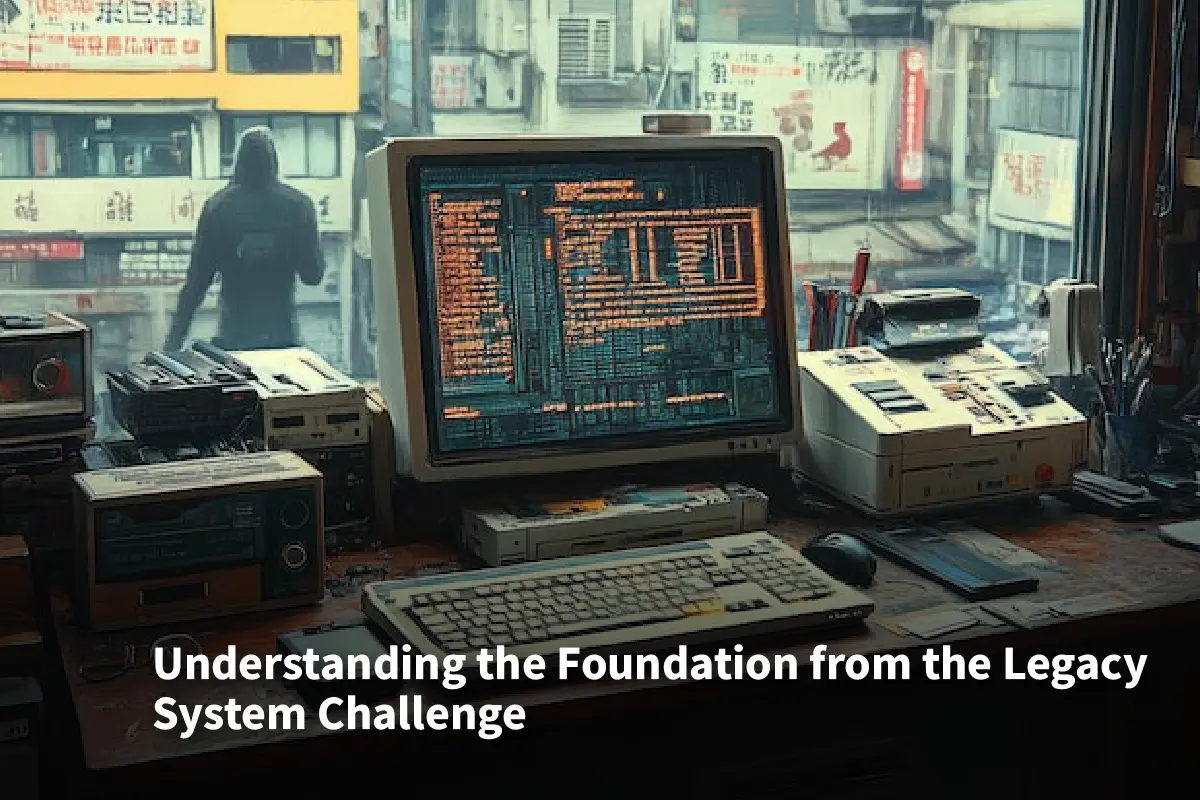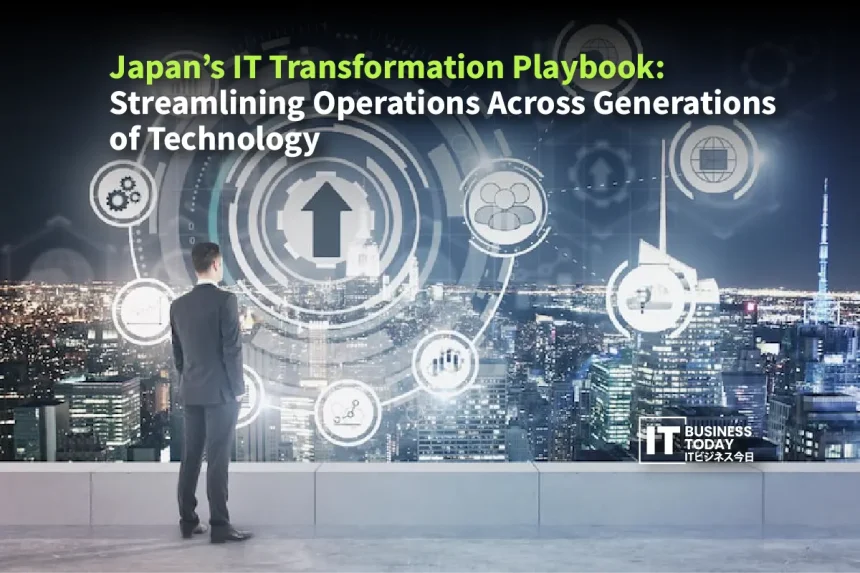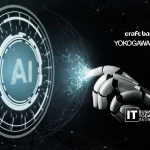日本は専門家が「2025年のデジタルクリフ」と呼ぶものに向かっています。皆さんも耳にしたことがあるかもしれません。古くなったITシステムが寿命を迎え、ほとんどサポートされていないにもかかわらず、ビジネスを維持している状態です。聞き覚えがありますよね?多くの企業がこのようなレガシー・システムに依存しています。何十年にもわたって機能してきたレガシー・システムですが、今や本当のリスクになりつつあります。メンテナンスコストは上昇の一途をたどり、インフラが追いつかない状況では、イノベーションを起こすことはほとんど不可能です。
このプレイブックは、ITトランスフォーメーションを支援するためのものです。すべてを一度に壊すことなく、罠から抜け出すためのステップ・バイ・ステップのアプローチを示しています。システムを近代化し、データをよりスマートに活用し、チームに変革の準備をさせます。目標は伝統を捨てることではありません。企業が競争力を維持し、次に何が来ても対応できるように、うまくいくことを新しいテクノロジーと融合させることです。
レガシーシステムへの挑戦から基盤を理解

で 日本レガシーITシステムは単なるソフトウェアではありません。レガシーITシステムは、企業が何十年にもわたり、安定性と長期的な関係を第一に、どのように取り組んできたかを示すものです。多くの企業は、信頼できるベンダーと巨大なオンプレミス・システムを構築しました。ケイレツ・モデルは、これを普通のことにしたのです。うまく機能していました。オペレーションは信頼できるものでした。しかし、時間の経過とともに、信頼性は硬直性に変わりました。
のような政府の業界団体。 ジェトロ の調査結果によると、多くの企業がいまだにこのような長年の IT 慣行を踏襲していることが明らかになりました。信頼できるベンダーや確立されたワークフローに依存しているため、新技術の導入が遅れ、組織が古いシステムに縛られているのです。
こちらもお読みください: バンキング2.0暗号技術革新が伝統的な金融とグローバル・バンキングの未来をどう変えるか
今、これらのシステムは物事を大きく遅らせる可能性があります。システムを稼働させ続けることは予算を食いつぶします。クラウドプラットフォームやAIのような新しいツールを導入するのは?簡単ではありません。データはサイロに閉じ込められています。チームは正しい情報を探すのに何時間も費やします。意思決定には必要以上に時間がかかり、チャンスは誰も気づかないうちに過ぎ去ってしまいます。
これは単なる技術的な頭痛の種ではありません。リーダーは成長の停滞を目の当たりにしています。グローバルな競争相手の動きはより速い。顧客は新しいサービスと迅速な納品を期待しています。古いシステムでは追いつけません。これを無視すれば、強力なレガシーを持つ企業でさえ、関連性を失う危険性があります。
良いニュースは、前進する道があるということです。 情報技術 変革とは、すべてを取り壊すことではありません。注意深く動き、うまくいっているものを維持し、徐々に柔軟なソリューションを導入していくことです。重要な部分はアップグレード。重要な部分は自動化。役立つところはシステムを接続。正しく行うことで、古いシステムは障害物ではなくなります。古いシステムは、成長と新しいアイデアのためのプラットフォームとなるのです。
コア・プレイブック
フェーズ1:近代化とインフラのオーバーホール
まず最初に。レガシーシステムの現実に直面しなければなりません。これらのセットアップの多くは、何十年も前から存在しています。ほとんど機能しています。しかし、その信頼性にはコストがかかります。今あるものを監査することから始めましょう。新しいプラットフォームに移行できるもの、本当にリプレースが必要なもの、そしてそのまま引退できるものを見極めましょう。驚くような発見があるかもしれません。チームは、誰もインストールした覚えのないプログラムが動いているのを発見することがよくあります。
次はクラウドへの移行です。クラウドファーストは単なる技術的な決断ではありません。メンテナンスコストを削減し、スケーリングを容易にし、新しいツールへの扉を開きます。しかし、一夜にしてすべてを置き換えることはできません。それは難しい。次のような企業があります。 日立 その方法を紹介します。Lumadaソリューションでは、クラウド化を進めながら、基幹システムにAIを追加しています。機能するものを維持し、必要なものを更新し、徐々に柔軟性を高めていくのです。実用的で完璧ではありませんが、うまくいっています。
この段階は基礎を固めることです。これがうまくいけば、レガシーの罠から逃れることができます。革新の余地を生み出し、効率を改善し、IT変革の次のフェーズに実際に備えることができます。
フェーズ2:データ主導のイノベーションとサービス統合
システムの故障がなくなれば、データを使って何か面白いことを始めることができます。データがサイロに閉じ込められていることはよくあることです。人々はレポートを探すのに何時間も費やします。イライラさせられます。最初のステップは、データを一箇所にまとめることです。そして AI と機械学習が実際に意味を持ち始めます。チームは、より速く傾向を把握し、より良い意思決定を行い、10枚のスプレッドシートを調べる時間を無駄にすることはありません。
新しいサービスが登場するのもこの時期です。請求書の承認を自動化したり、出荷を自動追跡したり。製品の使用状況を確認できるダッシュボードを顧客に提供するとか。些細なことが大きな効果を生むのです。効率化だけではありません。すでにあるものから新たな可能性を見出すことなのです。
ハイブリッド・クラウドが一般的です。すべてを一度に移行するのは危険です。ルール上、オンプレミスに残さなければならないデータもあります。クラウドとオンプレミスの両方を使うことで、何も壊すことなくゆっくりとイノベーションを進めることができます。派手さはありませんが、うまくいきます。
そうすれば、データは頭痛の種ではなくなります。データは、実際にビジネスを運営し、成長させる助けとなるのです。
フェーズ3:DXに対応した企業文化の醸成
最高の テック しかし、従業員にその準備ができていなければ、意味がありません。従業員には新しいスキルが必要です。私たちは、長年スプレッドシートを使ってきた人が突然クラウドツールを使う必要が出てくるのを見てきました。最初は怖いものです。ですから、まずは小さく始めましょう。時間を与えましょう。トライさせましょう。少し失敗させましょう。そうすることで、学習が定着するのです。
文化も少し厄介です。たいていのチームは一定のやり方に慣れています。一夜にして変えろというのは無理な話です。ちょっとした実験をしてみましょう。たとえ小さなことでも、小さな成功を祝いましょう。質問することを奨励しましょう。時には失敗してもいいように。それが、「カイゼン」が実際に意味することなのです。
そして、こういうことです。IT部門は単独で動くことはできません。他のチームと話し合う必要があります。実際に何が必要なのかを理解するのです。私たちは、正式なミーティングよりも、廊下での何気ないおしゃべりの方がより良い解決策を導き出すのを見てきました。ワークショップや共有プロジェクトも役に立ちますが、シンプルなコミュニケーションがトリックになることが多いのです。
そうすれば、物事は変わり始めます。人々は能力を感じチームは協力し合います。新しいツールの価値がわかります。ビジネスはより速く動き始めます。そして、それは単なる一過性のプロジェクトではありません。変革は日常業務の一部となります。ゆっくり。着実に。現実。
実際の成功例
日立のIT改革は一夜にして実現したわけではありません。すでにあるシステムにAIを追加し、業務の一部を少しずつクラウドに移行することから始めました。それには時間がかかりました。社員は新しいツールに慣れる必要があり、これまでとは違う働き方を考えなければならず、時にはミスを犯すこともありました。
しばらくすると、多くのルーチンワークが速くなりました。各部門に散らばっていたデータが見つけやすくなり、使いやすくなりました。メンテナンス・コストも下がりました。一部のチームは、デジタルで顧客にサービスを提供する新しい方法を思いつきました。
派手ではなかったですね。即席でもなく。ステップ・バイ・ステップで、少し面倒でしたが、うまくいきました。彼らが気づいたのは、小さな改善と忍耐、そしてチームに実験する余地を与えることが、実際に成果を生むということ。 情報技術 変身スティック。
レジリエントな未来への道

これらすべてを見て、本当に重要なことはいくつかあります。まず、一歩ずつ前進すること。一度にすべてを変えることはできません。システムを修正し、次にデータをよりスマートな方法で使い始め、最後に人材と企業文化に焦点を当てます。少しずつ行うことで、管理しやすくなり、実際に定着しやすくなります。
文化は非常に重要です。たとえ失敗しても、安心して新しいことに挑戦できる環境が必要です。もちろんスキルは役立ちますが、マインドセットとチームワークが新しい技術を実際に機能させるのです。チームが物事を理解するためのスペースがあれば、小さな実験が実際の改善につながるでしょう。
データも厄介です。データがうまく流れ、人々がその使い方を知っている場合にのみ役に立ちます。サイロを壊し、インサイトを共有し、新しいアイデアを試すこと。
IT変革は一過性のプロジェクトではありません。それは旅です。ゆっくりと、着実に、時には厄介に。学び続け、チームの成長を助け、実験を続ける企業が、最終的に強くなるのです。長く待ちすぎた企業は遅れをとります。今すぐ変わらなければ、取り残されるリスクがあります。







